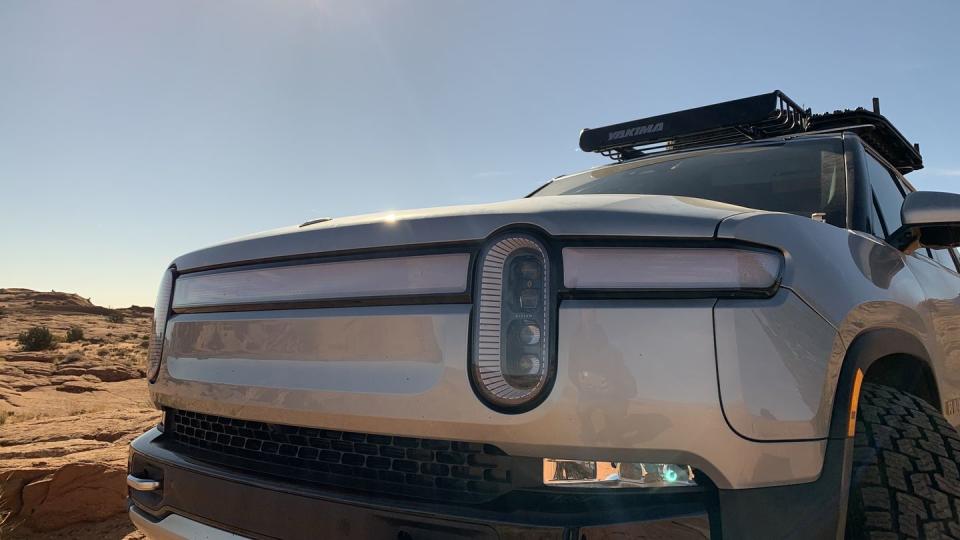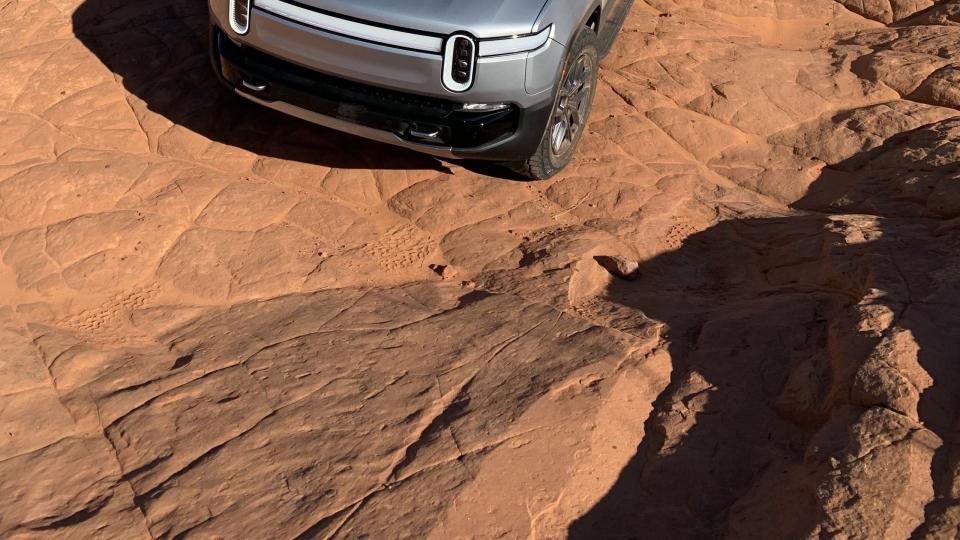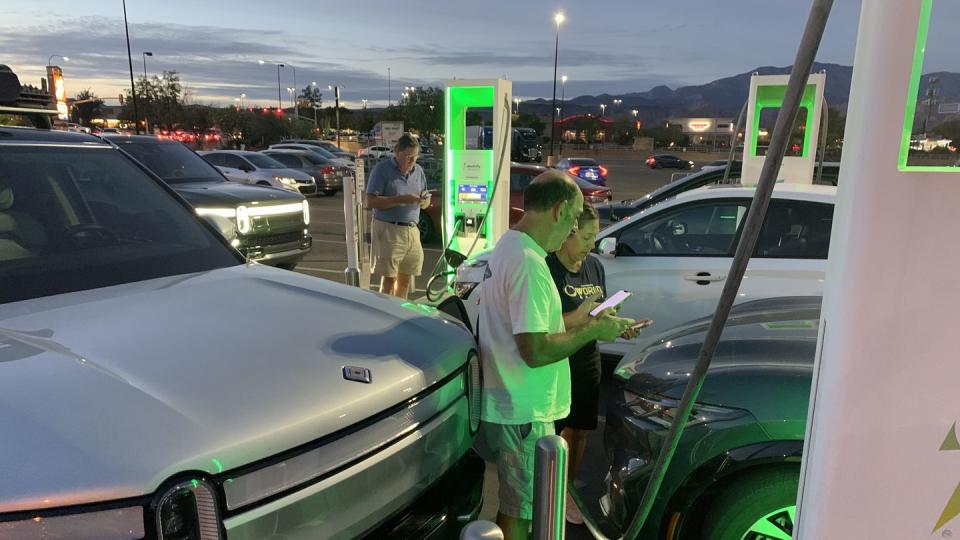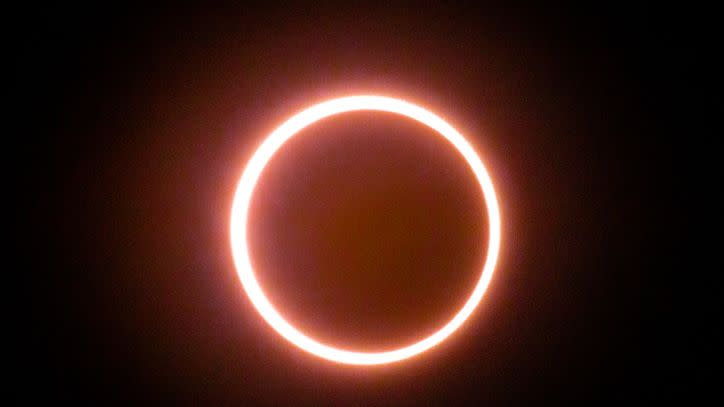How to Take a Rivian R1S SUV to the Desert to Watch an Eclipse

Rivian has sold over 50,000 trucks and SUVs to date.
We went almost 1500 miles across the desert Southwest on electricity alone and learned much about science and the charging network.
Don't believe everything you read on the internet.
We were somewhere around Barstow, on the edge of the desert, when the drugs began to kick in. Specifically, the Paxlovid. I had recovered from Covid only days before, had a pile of negative test results and a big box of SN95 masks. So my friend Scott and I, after having done much internet research, decided I was safe. We loaded up his Rivian R1S and headed northeast to the middle of Utah to see the eclipse.

It was as good a plan as any.
Scott had just bought his loaded Rivian R1S Adventure Edition for somewhere around $90,000 and it had only 167 miles on it. He had recently retired from a career making things that go up in space and say “beep,” so now he wanted to “go four-wheeling somewhere.”
Everyone knew the eclipse was coming and all the papers said “total” in front of the word “eclipse,” including maps of the “area of totality” in all their stories. For the record, the word “annular” and its description were nowhere to be found. At least by me and Scott. More on this later.
I myself had been laid down with my third round of Covid, (this job requires meeting a lot of people, many of whom cough), but all the web sources—the same web that neglected to describe the difference between annular and total—had said that five days after the onset of symptoms, with no persistent negative effects, you were safe to go maskless.
So off we went.
Power Enough for the Desert
The Rivian R1S is one of the better large electric SUVs on the market. Sure, you can get a Maybach EQS 680, Mercedes S-Class S580e, BMW iX M60, Tesla Model X, or even a Fisker Ocean (maybe? somewhere?). But none combined the off-road capability and high-tech uniqueness that Scott wanted.
He had owned a full-size, third-gen Bronco V8 before this, and liked going off-road. Being from a tech background, he was less afraid of new technology.
This R1S uses what Rivian calls the Quad-Motor powertrain: four inboard-mounted electric motors with one for each wheel. Altogether they make 835 hp and 908 lb-ft of torque.
Range is listed at 321 miles and 0-60 mph at 3.0 seconds but that’s on street tires. Scott’s had big 275/65R20 Pirelli Scorpions that ate into range and acceleration but also ate into any terrain he’d ever want to cross. The coming Dual-Motor powertrains offer slightly less performance but a lower cost.
Life’s full of trade-offs.
Not wanting to just pull off Interstate 15 around Beaver, Utah, like everyone else, Scott suggested we go all the way to Grand Staircase Escalante National Monument, specifically, to a feature called the Cosmic Ashtray, a round bowl about the size of a swimming pool with a rock poking up in the middle. It was as good a destination as any.
Escalante is 571 miles from Los Angeles. Google maps says that would take almost nine hours. But google maps isn’t accounting for an electric car. Even with Level 3 charging, where some chargers promised “up to” 350 kW, the drive would take about twice that.
But Where to Find Power?
We never saw anywhere near 350 kW charging. The most we ever got—and only for part of one charge—was a little over 200 at a Rivian charger. Most chargers seemed to operate at around 50 kW.
One, a Level 3 Electrify America unit in Cedar City, Utah, where only two of four chargers worked, sputtered out 34 kW. You could damn near pedal a bicycle faster than that.
The EV charging network is clearly in its infancy.

One interesting phenomenon was the camaraderie of EV drivers at each location. Rather than lock their doors, sit in their cars and stew, the EV drivers we met were all happy to talk. They got out of their cars, even in sketchy Walmart parking lots in the middle of the night, and chatted away like eager pledges at a freshman mixer.
They shared information about which chargers they thought were the best (ChargePoint) and which were the worst (Electrify America), and how nice it was that Rivian had its own fledgling network of free Level 3 chargers. We used the latter in Barstow and Las Vegas.

We used ChargePoint in Barstow (before we realized there was a Rivian charger there) and Kanab, Utah. We used Electrify America in St. George and Cedar City. In Escalante we plugged in to a Level 2 Tesla charger at midnight, which required an adapter, which we had, then rolled out our sleeping bags and slept like happy vagrants for seven hours while the charger hummed us to sleep.
Then there was the eclipse.
Not All Are Created Equal
Yes, I am actually going to complain about a natural phenomenon. Complaining about an eclipse is somehow un-American, or at least anti-science, like whining about your own bald head. It’s up there and it’s shining but it’s not exactly what you’d have preferred.
An annular eclipse is one in which the moon is farther away from Earth than a total eclipse. Therefore, the moon doesn’t cover the entire sun but rather fills in the interior of it, leaving a ring of regular old sun around it.
This sounds nice, and looks good in professionally shot photos, but in reality all it does is darken things up a bit, like wearing gas-station sunglasses or squinting. All those glorious eclipse photos you see online are zoomed way in and shot through various filters, then usually photoshopped onto spectacular backgrounds of great scenic beauty.
Off by the Cosmic Ashtray, several miles of four-wheeling out in the wilderness, all we saw was a little blop of sun pinpricked up in an otherwise gorgeous blue Utah sky. My plan is to sue Neil deGrasse Tyson. Or Issac Newton. Or somebody. (Or maybe do a little more research next time before driving 571 miles.)
But the Rivian, for its part, worked flawlessly, even in rock crawling, through deep sand, over washboard roads, and across miles and miles of Interstate. You can set the drive mode on the big central screen and the car reacts.
For sand and off-road it rises up, for highways it hunkers down. There are eight drive modes, four for on road, four for off. The modes “let drivers adjust ride height, suspension stiffness, accelerator pedal response, all-wheel drive and more to optimize for comfort, efficiency or performance in virtually any terrain,” Rivian boasts.
On our trip we went 1413 miles that included everything a car brochure might offer, and the Rivian never faltered.
What did this all mean? Do your astronomy homework! And do your car-buying homework. For the latter, you might find that the Rivian is the best choice in the “somewhat expensive but confidently hip” category.
Share your own experiences with solar eclipses of all varieties—and of how you got to see them—in the comments below.

 Yahoo Autos
Yahoo Autos 